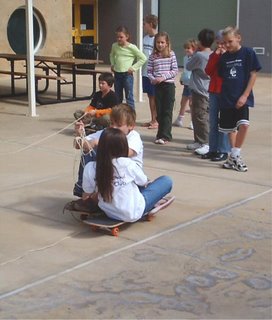 This week's exciting Explora Homeschool Science Class was all about the Newton's Laws.Basically, Newton's Laws of Motion describe only the motion of a body as a whole and are valid only for motions relative to a reference frame. The following are brief modern formulations of Newton's three laws of motion:
This week's exciting Explora Homeschool Science Class was all about the Newton's Laws.Basically, Newton's Laws of Motion describe only the motion of a body as a whole and are valid only for motions relative to a reference frame. The following are brief modern formulations of Newton's three laws of motion:~~~~~~~~~~~~~~~~~~
***First Law***
"An object will stay at rest or move at a constant speed in a straight line unless acted upon by an unbalanced force."

 As you can see in this experiment, a special cart rode along a track either empty, or carrying differing levels of weight. The cart traveled faster and straighter with no weight and slower and less straight with the weight.
As you can see in this experiment, a special cart rode along a track either empty, or carrying differing levels of weight. The cart traveled faster and straighter with no weight and slower and less straight with the weight.~~~~~~~~~~~~~~~~~~~~~~~
***Second law***
"The rate of change of the momentum of a body is directly proportional to the net force acting on it, and the direction of the change in momentum takes place in the direction of the net force."

 The experiment involved filling balloons with air and attaching them to a straw on a string and allowing the balloons to travel as fast or as slow as they were able. The balloons with more air traveled faster and straighter, while the balloons that were less filled traveled slower and ended their journey sooner.
The experiment involved filling balloons with air and attaching them to a straw on a string and allowing the balloons to travel as fast or as slow as they were able. The balloons with more air traveled faster and straighter, while the balloons that were less filled traveled slower and ended their journey sooner.~~~~~~~~~~~~~~~~~~~~~~
***Third law***
To every action (force applied) there is an equal but opposite reaction (equal force applied in the opposite direction)."
 (Conlin is Jackson & Jeremiah's favorite instructor)
(Conlin is Jackson & Jeremiah's favorite instructor)

 In the experiment to test this theory, the students took turns sitting on skateboards at the opposite ends of a rope. Each took a turn pulling the other and then both pulled at the same time realizing that the theory is in fact, more often than not, true.
In the experiment to test this theory, the students took turns sitting on skateboards at the opposite ends of a rope. Each took a turn pulling the other and then both pulled at the same time realizing that the theory is in fact, more often than not, true.~~~~~~~~~~~~~~~~~~~
Note: It is important to note that these three laws together with his law of gravitation provide a satisfactory basis for the explanation of motion of everyday macroscopic objects under everyday conditions. However, when applied to extremely high speeds or extremely small objects, Newton's laws break down; this was remedied by Albert Einstein's Special Theory of Relativity for high speeds and by quantum mechanics for small objects.
My buddy, Sorscha, who always has a HUGE hug for me!


No comments:
Post a Comment